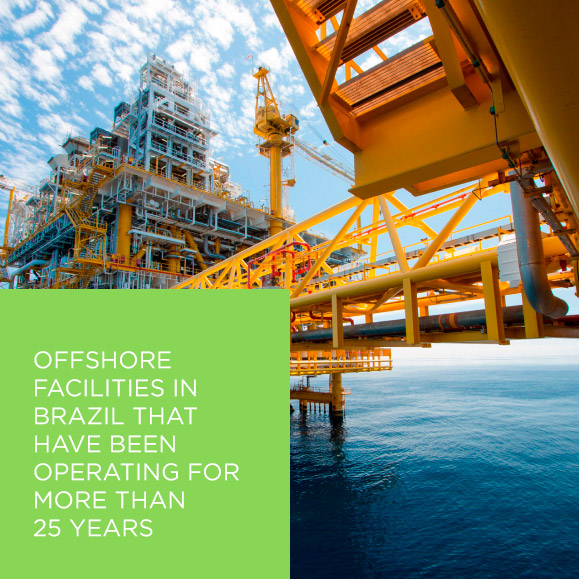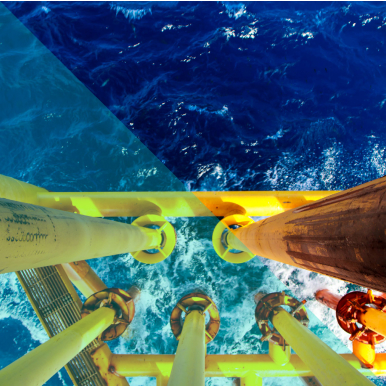Uncharted Waters for the Offshore Industry
The Brazilian offshore industry is going through two different times. While it is experiencing a fast pace of growth, it is also facing the challenge of shutting down production systems and structures in fields that have reached productive maturity — one such example is the Campos Basin, which accounts for over 80% of Brazil’s overall production.

Spending for the decommissioning of these structures is set to increase, reaching nearly BRL 50 billion (USD 9.52 billion) by 2040, according to data from Brazil’s National Petroleum Agency (ANP).
Hoje, ainda de acordo com dados da ANP, 66 Today, also according to data from the ANP, there are 66 offshore facilities in Brazil that have been operating for more than 25 years and are in the process of being decommissioned. A further 23 platforms have been operating for between 15 and 25 years, which reinforces the need for a compatible insurance solution to support this stage.
The costs for the execution of these dismantling projects are different depending on the specifics of each project, the variables of which include technical and geographical characteristics, such as the length and complexity of the pipeline networks; the layout of the subsea equipment; and, especially, decommissioning strategies that comply with regulatory requirements.
So, what is going to be required to enable the execution of these projects? A preliminary mapping covering all variables, attributing the appropriate weightings and correlating the impacts so they can be correctly calculated and controlled, such that the ultimate planned objective will not be compromised or quashed. Since this is a relatively new demand, Brazil does not yet have a set of consolidated guidelines. To deal with the absence of a regulatory framework, insurers seek common understandings among the ANP, IBAMA (Brazilian Institute of the Environment and Renewable Natural Resources), the Navy, and other bodies, which have already advanced the discussions in a public hearing held in January of this year, wherein the decision-making criteria were debated for the removal of structures and the divestment and reversion of assets.
Experience in other countries tells us that because of the negative impact on biodiversity and the commercial impact on fishing, complete removal of the structures is not always the best option. That’s why it’s important to evaluate other alternatives, such as partial removal of only the topside, towing the structure to a designated location, and/or toppling the structure down to the seabed for the formation of artificial reefs.
Here in Brazil, the draft resolution that was publicly debated by the regulatory agencies covers important topics that run from the exploration phase up to final operational shutdown. A Facility Decommissioning Program (PDI, in Portuguese) is to be submitted to the ANP for approval, including technical rationale in terms of the selection of the end date for production. The document does not recommend early shutdown of the field before all economically viable forms of recovery have been exhausted.
Obligations in terms of the transfer of the dismantled facilities to the appropriate waste-disposal location have been raised, as has the preparation of an environmental restoration plan for the ring-fence areas. The resolution under discussion also touches on the development of a nautical chart to map out the remaining structures so vessels can avoid hazards.

What is the biggest challenge facing the Brazilian industry? Our primary reserves are located in deep water, which requires complex submarine and production distribution systems.
What is the biggest challenge facing the Brazilian industry? Our primary reserves are located in deep water, which requires complex submarine and production distribution systems. In addition, it is not yet possible to accurately predict the project’s overall costs, since the regulatory aspect is still in ongoing.
A lower-than-expected oil price, as we have today, could be interpreted as a catalyst for the decommissioning process since the technologies used in the recovery of mature fields could start to be seen as no longer economically viable.
One of the discussions among the main players is that the resolution should objectively define where the operator’s liability begins and ends when farming in/farming out its activities. This is an important point, so that companies that acquire mature fields don’t have to assume a liability larger than they can financially bear and so the original operators can determine the extent of their expenditures over the field’s life cycle.
”In addition, it’s important to note that there has been a significant evolution in the definition of the requirements and restrictions for decommissioning offshore units”
In addition, it’s important to note that there has been a significant evolution in the definition of the requirements and restrictions for decommissioning offshore units; however, greater clarification is still required for the determination of the best practices to be adopted by the industry in each scenario. We know that this is part of a learning curve that will be climbed through the sharing of lessons learned and the adaptation of experiences by reinterpreting and validating them in the Brazilian context and adding our perspectives on submarine setups in deep waters of the Brazilian offshore. It’s not enough to simply “tropicalize” other countries’ experiences, since they have historically worked with a different set of conditions than we have here, such as shallow waters and different climates.
It is expected that the offshore market will arrive at a consensus on the resolution, considering all the risks involved in the process, aligning socioeconomic interests with environmental aspects, prioritizing risk reduction, and thus mitigating the uncertainties around this issue.
Narely Nicolau de Paula holds a bachelor’s degree in Petroleum Engineering and a specialization in offshore systems from COPPE/UFRJ. She is an Energy Underwriter for Austral Seguradora.